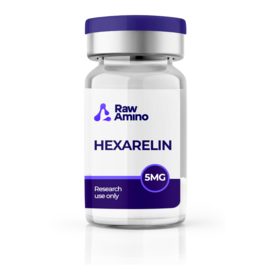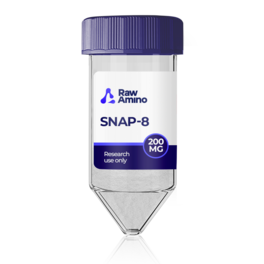
PE-22-28 – 8MG
$55.00
Discount per Quantity
| Quantity | Discount | Price |
|---|---|---|
| 5 - 8 | 5% | $52.25 |
| 9 + | 10% | $49.50 |
Scientific Overview of PE-22-28
PE-22-28 is a synthetic analog derived from Spadin, a peptide originating from Sortilin. Spadin has been described as a naturally secreted peptide that appears to interact with TREK-1 (TWIK-related-potassium channel), a two-pore potassium channel considered relevant in the regulation of neuronal excitability and neurogenic pathways. Research involving animal models suggests that the deletion or modulation of TREK-1 may influence mood-related behaviors, leading to further study into synthetic variants such as PE-22-28. This analog represents a shorter seven-amino acid sequence of Spadin, designed with the intention of offering potentially improved stability and research versatility. While exploration of PE-22-28 itself remains limited, the growing body of Spadin-based research has positioned it as a compound of scientific interest.
Alternative Names: Spadin Analog, PE2228, TREK-1 Antagonist, PE 22 28, Sortilin Derivative
Studies and Research Data
PE-22-28 Interactions with TREK-1 Channels
PE-22-28 has been linked to TREK-1 receptors, a class of two-pore potassium channels. These channels appear to play a role in regulating neuronal excitability and are found in brain regions such as the hippocampus, amygdala, and prefrontal cortex. Spadin-based research suggests that modulation of TREK-1 may provide protective qualities against excitotoxic conditions and could encourage pathways associated with neurogenesis. PE-22-28, given its structural similarity, is often hypothesized to share or expand upon these interactions.
Associations with BDNF Pathways
Explorations into Spadin indicate a possible relationship with Brain-Derived Neurotrophic Factor (BDNF), a key molecule involved in synaptic plasticity, neuronal survival, and growth. Research suggests Spadin might indirectly influence BDNF regulation, possibly through serotonin signaling and TREK-1 modulation. Since PE-22-28 is a synthetic analog, it is hypothesized that it may carry similar or potentially more pronounced interactions with BDNF-related pathways, though direct evidence remains limited.
PE-22-28 Research on Neurogenesis
Animal model data suggest that compounds like Spadin may stimulate rapid neurogenic activity, potentially involving pathways regulated by CREB (cAMP response element-binding protein). Observations include an increase in phosphorylated CREB levels, which may contribute to synaptic and neuronal development. Experimental results with Spadin have indicated rises in neuronal precursor activity and associated markers, leading researchers to suggest that PE-22-28 may carry comparable potential for supporting neurogenic processes in controlled models.
PE-22-28 Potential Impact on Serotonin Signaling
Spadin has been linked to serotonin neurotransmission, particularly through interactions involving TREK-1 and modulation of neurons in the Dorsal Raphe Nucleus. Reports suggest that spadin may amplify serotonin signaling by reducing inhibitory feedback. Additional findings indicate that these pathways might be influenced by interactions with metabotropic glutamate receptors (mGluR2/3), pointing to a broader regulatory mechanism. Given these associations, PE-22-28 is expected to share potential parallels in serotonin-related investigations.
Early Findings in Muscle Research
Some exploratory studies have considered TREK-1 activity in muscle-related function. TREK-1 channels may play a role in responses to mechanical stress and could influence contractility or relaxation. While the focus has primarily been on neuronal regulation, researchers suggest that PE-22-28 and related analogs might provide new perspectives on the role of potassium channels in muscular physiology.
Conclusion
PE-22-28 is a synthetic Spadin analog currently under early exploration as a potential research tool. Preliminary findings suggest it may share parallels with Spadin in terms of TREK-1 modulation, interactions with neurogenic pathways, possible influence on serotonin activity, and exploratory considerations in muscle-related mechanisms. While scientific data remains limited, the compound is being investigated as part of a broader effort to understand the functions of TREK-1 channels and their impact on neuronal and physiological systems.
References
- Moha ou Maati, Hamid et al. “The peptidic antidepressant spadin interacts with prefrontal 5-HT(4) and mGluR(2) receptors in the control of serotonergic function.” Brain structure & function vol. 221,1 (2016): 21-37. doi:10.1007/s00429-014-0890-x
- R. S. Duman, S. Nakagawa, and J. Malberg, “Regulation of adult neurogenesis by antidepressant treatment,” Neuropsychopharmacol. Off. Publ. Am. Coll. Neuropsychopharmacol., vol. 25, no. 6, pp. 836–844, Dec. 2001, doi: 10.1016/S0893-133X(01)00358-X.
- C. Devader et al., “In vitro and in vivo regulation of synaptogenesis by the novel antidepressant spadin,” Br. J. Pharmacol., vol. 172, no. 10, pp. 2604–2617, May 2015, doi: 10.1111/bph.13083.
- H. Moha Ou Maati et al., “Spadin as a new antidepressant: absence of TREK-1-related side effects,” Neuropharmacology, vol. 62, no. 1, pp. 278–288, Jan. 2012, doi: 10.1016/j.neuropharm.2011.07.019.
- Djillani A, Pietri M, Moreno S, Heurteaux C, Mazella J, Borsotto M. Shortened Spadin Analogs Display Better TREK-1 Inhibition, In Vivo Stability and Antidepressant Activity. Front Pharmacol. 2017 Sep 12;8:643. doi: 10.3389/fphar.2017.00643. PMID: 28955242; PMCID: PMC5601071.
- A. J. Silva, J. H. Kogan, P. W. Frankland, and S. Kida, “CREB and memory,” Annu. Rev. Neurosci., vol. 21, pp. 127–148,1998, doi: 10.1146/annurev.neuro.21.1.127.
- Mazella J, Pétrault O, Lucas G, Deval E, Béraud-Dufour S, Gandin C, El-Yacoubi M, Widmann C, Guyon A, Chevet E, Taouji S, Conductier G, Corinus A, Coppola T, Gobbi G, Nahon JL, Heurteaux C, Borsotto M. Spadin, a sortilin-derived peptide, targeting rodent TREK-1 channels: a new concept in the antidepressant drug design. PLoS Biol. 2010 Apr 13;8(4):e1000355. doi: 10.1371/journal.pbio.1000355. PMID: 20405001; PMCID: PMC2854129.
- A. Djillani, J. Mazella, C. Heurteaux, and M. Borsotto, “Role of TREK-1 in Health and Disease, Focus on the Central Nervous System,” Front. Pharmacol., vol. 10, Apr. 2019, doi: 10.3389/fphar.2019.00379.
- Q. Lei, X.-Q. Pan, S. Chang, S. B. Malkowicz, T. J. Guzzo, and A. P. Malykhina, “Response of the human detrusor to stretch is regulated by TREK-1, a two-pore-domain (K2P) mechano-gated potassium channel,” J. Physiol., vol. 592, no. 14, pp. 3013–3030, Jul. 2014, doi: 10.1113/jphysiol.2014.271718.
Disclaimer:
The products mentioned are intended solely for laboratory research and in-vitro experimentation. They are not approved for human or animal use of any kind. All details provided are for educational purposes only. By purchasing from this site, you agree to comply with our Terms and Conditions.
16 reviews for PE-22-28 – 8MG
Only logged in customers may leave a review.







daniel howan –
tara Janu –
Benjamin Franklin –
peptides prpi –
jarnold S –
William A –
Dennis H –
kenneth J –
armstrong patricia –
paullee Amy –
andrew collier –
andrew collierr –
albert Henry –
Brian U –
angel amay –
Joseph P –